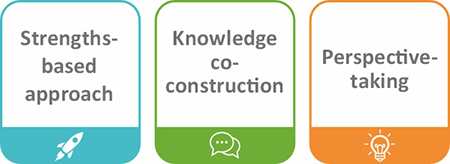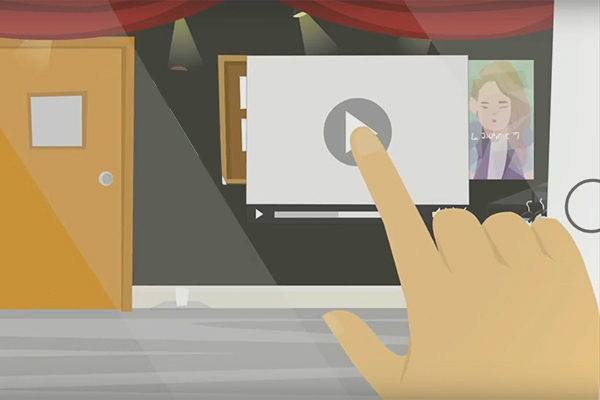‘I am’ Digital Story (method 1): empowering marginalised voices through a ‘strengths-based’ approach, ‘knowledge co-construction’ and ‘perspective-taking’
Presenter(s): Sarah Parsons and Samantha Holt

This method uses filmmaking processes to create an ‘I am’ Digital Story of participants’ experiences – short videos that give information about participants. The method supports people who have been marginalised or ignored by research practice due to assumptions that their ‘voices are too hard to reach’.
The method engages marginalised voices in two ways:
1. By facilitating co-construction to enable their identities and lived experiences to be documented and shared the way they choose.
2. By making the output of the project accessible to the person at the heart of the research.
Participants are the storytellers in the process. Positioning them as ‘capable knowers’ provides epistemic justice as it enables more diverse participation and representation in research (Catala et al., 2021).

Strengths-based approach
This approach guides the storytellers through the process of creating their own story and helping them to present their ‘best self’ to other people, so that they have autonomy over what information is shared.
The participant uses a selection of photos and/or film clips accompanied by a first-person narrative, carefully put together, to provide a more holistic representation of who the person is. The person tells their own story as much as possible; they are the storyteller.
The method applies a strengths-based framework so that storytellers focus on sharing the things they are good at and interested in, rather than what they cannot do or do not like doing. The strengths-based framework includes the spaces they like to be, and people they enjoy spending time with. They are also encouraged to show the support they might need to feel relaxed and happy and when things are going well.
To generate a more holistic representation, use the following seven main areas (informed by the Froebelian principles of childhood) to help participants think about what to include in their Story: 1. Spaces, 2. People and interactions, 3. Independence and Agency, 4. Objects and interests, 5. Communication and expression, 6. Support, 7. Skills and capabilities.
> Download a template with 7 areas to focus when developing your strengths-based framework. The template is based on our work with children and young people, yet it could be adapted to reflect the groups you are working with.

This strengths-based framework is based on work in early years settings with young children. We have since adapted and applied it to work with older children and young people.
Knowledge co-construction
Some people may need more help to tell their story and would need to co-construct the project with people who know them well, such as a researcher, a teacher, family members, care workers, or friends.
New knowledge is created (the ‘what’) through the shared endeavours of research and practice working together equally (the ‘how’) (Parsons et al., 2022; p.1065).
The strengths-based framework supports this by showing advocates of people, such as those with learning and/or communication difficulties, how to support the co-creation of another’s story.
Storytellers (and their advocates) are guided to work in a way that prompts story creation without being prescriptive. This means being aware of power relations and promoting the voices and autonomy of people participating in the research.
Perspective-taking
The approach encourages supporters to ‘walk in the shoes’ of the person. Showing Wearcam footage allows the viewer to see the world from the storyteller’s perspective, enabling their experiences to be shared in a unique way.
The approach prompts perspective-taking by people who know the storyteller well when helping to decide what photos or film clips to include and creating the narrative that steers the audience through the story.
Being able to see the world from another’s point of view is an integral part of this process (Lambert, 2013). This is especially important for people who communicate differently and may experience the world differently (Guldberg et al., 2017; Parsons et al., 2015).
> Download a template with key questions to consider in creating your Digital Story method work.
- Our thanks to Dr. Gil Dekel for his support in preparing this resource.
___
References
Catala, A., Faucher, L., & Poirier, P. (2021). Autism, epistemic injustice, and epistemic disablement: A relational account of epistemic agency. Synthese, 199(3-4), 9013-9039. https://link.springer.com/article/10.1007/s11229-021-03192-7
Guldberg, K., Parsons, S., Porayska-Pomsta, K. & Keay-Bright, W. (2017) Challenging the knowledge transfer orthodoxy: knowledge co-construction in technology enhanced learning for children with autism. British Educational Research Journal, 43(2), 394-413. https://bera-journals.onlinelibrary.wiley.com/doi/full/10.1002/berj.3275
Parsons, S., Guldberg, K. Porayska-Pomsta, K. & Lee, R. (2015) Digital stories as a method for evidence-based practice and knowledge co-creation in technology-enhanced learning for children with autism. International Journal of Research & Method in Education, 38(3), 247-271. https://www.tandfonline.com/doi/full/10.1080/1743727X.2015.1019852
Parsons, S., Kovshoff, H., & Ivil, K. (2022). Digital stories for transition: co-constructing an evidence base in the early years with autistic children, families and practitioners. Educational review, 74(6), 1063-1081. https://www.tandfonline.com/doi/full/10.1080/00131911.2020.1816909
‘I am’ Digital Story (method 3): using a two-step consent procedure
‘I am’ Digital Story (method 5): screening and sharing as a drive to enact positive change
About the author
Sarah Parsons is Professor of Autism and Inclusion at the University of Southampton. She is a member of the Centre for Research in Inclusion, and Autism Community Research Network @ Southampton (ACoRNS).
Dr Samantha Holt is a Visiting Research Fellow (Psychology) at the University of Sussex. She is a Research Fellow in the School of Psychology’s Children and Technology Lab.
- Published on: 17 May 2023
- Event hosted by: Southampton
- Keywords: Digital Story | Film | Experiences | strengths-based | knowledge co-construction |
- To cite this resource:
Sarah Parsons and Samantha Holt. (2023). ‘I am’ Digital Story (method 1): empowering marginalised voices through a ‘strengths-based’ approach, ‘knowledge co-construction’ and ‘perspective-taking’. National Centre for Research Methods online learning resource. Available at https://www.ncrm.ac.uk/resources/online/all/?id=20796 [accessed: 8 December 2025]
⌃BACK TO TOP


